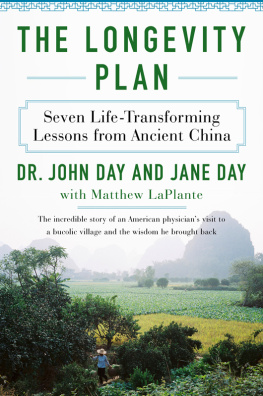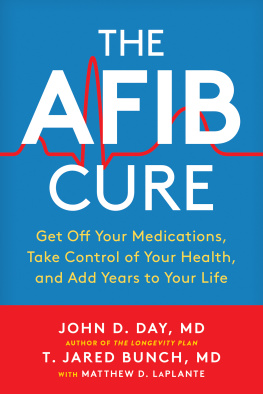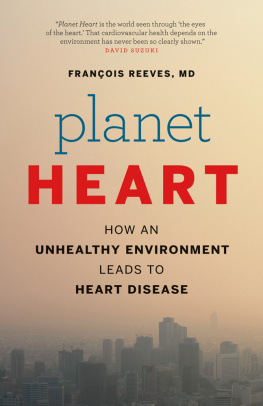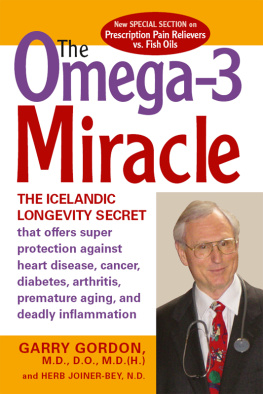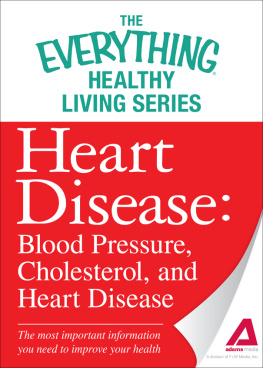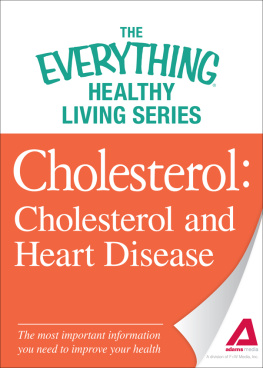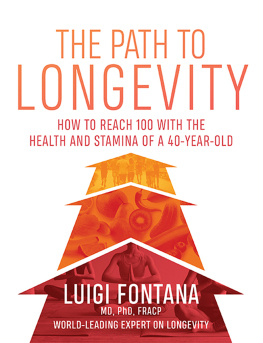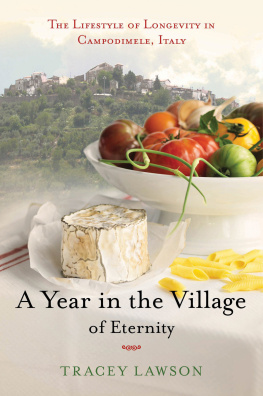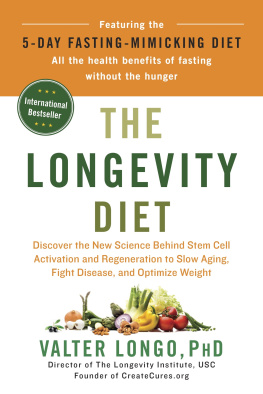THIS BOOK WOULD NEVER HAVE COME TO BE WITHOUT THE KEY contributions of many people. It was only after the urging of my wife, Jane, that we made the first of many research journeys to Longevity Village as a family. She has led by example, striving to live and teach the principles of Longevity Village in our own home even before our journeys there began.
I wish to thank the physicians, nurses, and other staff members at my hospital who encouraged me to write this book after hearing me present our findings at our hospitals grand rounds. Never in my wildest dreams would I ever have imagined writing a book.
It was Drs. Charles Mallender and Dan Nadeau who pointed me in the right direction after my colleagues convinced me to write this book. Special thanks to Lone Jensen who took our experiences in Longevity Village and translated them into a book proposal. Thanks to Trena Keating for believing in this book, guiding us along the way, as well as her many hours spent revising early versions.
I wish to thank Gail Winston and her team at HarperCollins for also believing in the message of this book and providing us a way to share our message of hope. Her vision and editorial insights helped us create a much better book than we could have done on our own.
Thanks to Jennifer Nelson and Alecia Anderson who organized the patient Longevity Plan Study and helped so many of our patients adopt the health lessons of Longevity Village to turn their lives around. Thanks to Darryll Gilliland for making possible all of the community Longevity Plan seminars.
Special thanks to Matt Walker and Brennan Snow, from the Tiger in a Jar video team, who documented our second research trip to Longevity Village on film. Thanks to Lv Zeng, my Chinese language coach, who helped me maintain my Chinese language skills to do this research, made arrangements for our research team, helped with interviews, and organized the analysis of the genetic samples.
Thanks to Drs. Yunlong Xia, Yan He, and Leon Ma in China for helping me with the research behind this book.
I am especially indebted to my collaborating writer, Matthew LaPlante, for getting the thoughts, ideas, and experiences out of my head and down on paper. He is an insightful thinker, an incredibly talented writer, and a good friend. Thanks as well to Matthews wife and daughter, Heidi and Mia, for their support of this project and journeying with us to Longevity Village.
I could not have done this without the lessons learned from my patients. It was our joint struggle with medical challenges that led me on this journey in the first place. Your love, support, and eagerness to learn about this village motivated me through the difficult periods.
Lastly, thanks to our children and my parents. It was special to share many research trips to Longevity Village and the transformational journey with you. Thank you Dad for believing in me and the message of this book.
D R . J OHN D. D AY is a cardiologist and medical director of heart rhythm specialists at Intermountain Medical Center in Salt Lake City, Utah. He received a medical degree from Johns Hopkins and completed his cardiology training at Stanford University. Dr. Day has published more than one hundred medical studies and gives lectures throughout the world on various heart topics. He is the former president of the Heart Rhythm Society and currently serves as the Utah governor of the American College of Cardiology.
J ANE A NN D AY , MA, received her masters degrees from the Georgetown School of Foreign Service and UC Santa Cruz. Her work has taken her throughout Asia, the Middle East, and North Africa, where she has empowered communities in need with self-reliance and entrepreneurial tools. Jane has published her work in international academic journals. She currently enjoys facilitating executive strategy sessions and seminars. Above all, Jane is the joyful mother of four adventurous young souls who provide her with daily opportunities to practice and teach the seven principles.
M ATTHEW L A P LANTE teaches news writing and crisis reporting at Utah State University. He is the cowriter of Inheritance: How Our Genes Change Our Lives, and Our Lives Change Our Genes with Dr. Sharon Moalem. A former national security reporter for the Salt Lake Tribune , his work also has appeared in the Washington Post and the Los Angeles Daily News , and on CNN.com.
Discover great authors, exclusive offers, and more at hc.com .
(* Research to which Dr. John Day contributed)
Abbott, A. (2014) Sugar substitutes linked to obesity. Nature.
Adar, S., et. al. (2013) Fine particulate air pollution and the progression of carotid intima-medial thickness: A prospective cohort study from the multi-ethnic study of atherosclerosis and air pollution. PLOS Medicine.
Andersen-Ranberg K., et. al. (2013) Cardiovascular diseases are largely underreported in Danish centenarians. Age Aging .
Armstrong, G., Conn, L., and Pinner, R. (1999) Trends in infectious disease mortality in the United States during the 20th century. Journal of the American Medical Association.
Babisch, W. (2000) Traffic noise and cardiovascular disease: Epidemiological review and synthesis. Noise Health.
Barrett, D. (2007) Maximizing the nutritional value of fruits and vegetables. Food Technology.
Benedict, C., et. al. (2014) Acute sleep deprivation increases serum levels of neuron-specific enolase (NSE) and S100 calcium binding protein B (S-100B) in healthy young men. Sleep.
Bibbins-Domingo, K. (2014) Sodium intake in populations: Assessment of evidence. Journal of the American Medical Association: Internal Medicine.
Boschmann, M., et. al. (2003) Water-induced thermogenesis. Journal of Clinical Endocrinology and Metabolism.
Boursi, B., et. al. (2015) The effect of past antibiotic exposure on diabetes risk. European Journal of Endocrinology.
Boyle, P., et. al. (2009) Purpose in life is associated with mortality among community-dwelling older persons. Psychosomatic Medicine.
Boyle, P., et. al. (2012) Effect of purpose in life on the relation between Alzheimer disease pathologic changes on cognitive function in advanced age. Archives of General Psychiatry.
Buckley, C. (July 7, 2012) In New York City, indoor noise goes unabated. The New York Times.
Buettner, D. (2010) The Blue Zones: Lessons for Living Longer from the People Whove Lived the Longest. National Geographic.
* Bunch T., et. al. (2009) Atrial fibrillation is independently associated with senile, vascular, and Alzheimers dementia. Heart Rhythm .
* Bunch, T., et. al. (2010) Patients treated with catheter ablation for atrial fibrillation have long-term rates of death, stroke, and dementia similar to patients without atrial fibrillation. Heart Rhythm.
* Bunch, T., et. al. (2011) Patients treated with catheter ablation for atrial fibrillation have long-term rates of death, stroke, and dementia similar to patients without atrial fibrillation. Journal of Cardiovascular Electrophysiology.
* Bunch, T. and Day, J. (2015) Adverse remodeling of the left atrium in patients with atrial fibrillation: When is the tipping point in which structural changes become permanent? Journal of Cardiovascular Electrophysiology.
* Bunch, T., et. al. (2015) Five-year outcomes of catheter ablation in patients with atrial fibrillation and left ventricular systolic dysfunction. Journal of Cardiovascular Electrophysiology.
* Bunch, T., et al. (2016) Atrial fibrillation patients treated with long-term warfarin anticoagulation have higher rates of all dementia types compared with patients receiving long-term warfarin for other indications. Journal of the American Heart Association .
Campbell, T. and Campbell, T. (2006) The China Study: Startling Implications for Diet, Weight Loss and Long-term Health. BenBella Books.
Campbell T., Parpia, B., and Chen J. (1998) Diet, lifestyle, and the etiology of coronary artery disease: the Cornell China study. American Journal of Cardiology.
Next page
